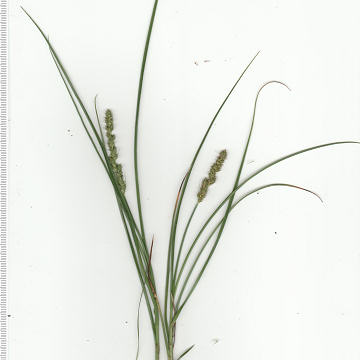

Carex vulpinoidea - (image 1 of 6)
Taxonomy
Family: Cyperaceae
Section Multiflorae
Habitat
Common on wet, open ground.
Associates
Distribution
Newfoundland to FL, west to British Columbia, WA, and AZ.
Morphology
Stems stout, tufted, to 1 m; aphyllopodic; leaves restricted to the lower 1/2 or 2/3 of the stem, mostly flat, 2-5 mm wide, longer than the flowering stems; ventral side of sheaths dotted with red and corrugated; inflorescence compound towards the base, dense above, often interrupted, to 10 cm long and 1.5 cm wide; spikes androgynous, crowded, sessile, small and few-flowered; bracts small, setaceous, the lowest to 5 cm long; pistillate scales pale brown, slender, with an awn up to 3 mm long; perigynia flattened to planoconvex, green to pale brown, 2-3.2 mm, elliptic, mostly nerveless, serrulate-margined toward the tip; achene lenticular; stigmas 2.
Notes
Fruiting July to August
Wetland indicator: OBL
Differs from other "fox sedges" in that the pistillate scales have a distinct awn and perigynia that are rounded at the base and scarcely spongy. The other fox sedges (section Vulpinae) have awnless pistillate scales, or if awned than the perigynia with a distinctly spongy and broad, subtruncate base. Carex annectens is most similar but has leaves that are shorter than the flowering stems and golden brown perigynia; its scales are sometimes awned but the awns are relatively short (to 1.5 mm).
References
Curtis, L. 2006. Woodland Carex of the upper Midwest. Lake Villa, IL.
Gleason, Henry A. and A. Cronquist. 1991. Manual of Vascular Plants of
Northeastern United States and Adjacent Canada. Second Ed.
The New York Botanical Garden. Bronx, NY
Swink, F. and G. Wilhelm. 1994. Plants of the Chicago Region.
Indiana Academy of Science. The Morton Arboretum. Lisle, Illinois.
|
© Michael Hough 2010 |